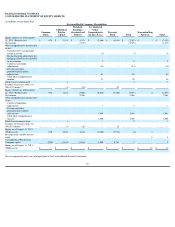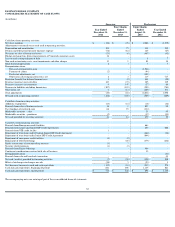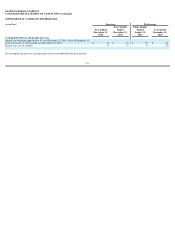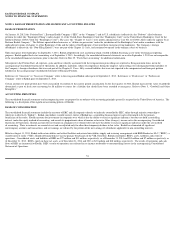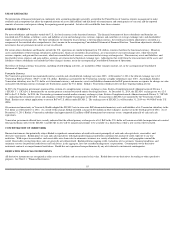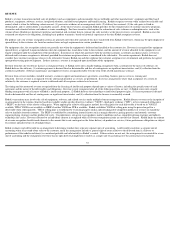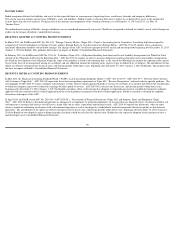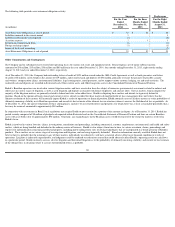Kodak 2014 Annual Report Download - page 62
Download and view the complete annual report
Please find page 62 of the 2014 Kodak annual report below. You can navigate through the pages in the report by either clicking on the pages listed below, or by using the keyword search tool below to find specific information within the annual report.
INCOME TAXES
Kodak recognizes deferred tax liabilities and assets for the expected future tax consequences of operating losses, credit carry-forwards and temporary differences
between the carrying amounts and tax basis of Kodak’s assets and liabilities. Kodak records a valuation allowance to reduce its net deferred tax assets to the amount that
is more likely than not to be realized. For discussion of the amounts and components of the valuation allowances as of December 31, 2014 and 2013, see Note 14,
“Income Taxes.”
The undistributed earnings of Kodak’s foreign subsidiaries are not considered permanently reinvested. Kodak has recognized a deferred tax liability (net of related foreign tax
credits) on the foreign subsidiaries’ undistributed earnings.
RECENTLY ADOPTED ACCOUNTING PRONOUNCEMENTS
In March 2013, the FASB issued ASU No. 2013-05, “Foreign Currency Matters (Topic 830)—Parent’s Accounting for the Cumulative Translation Adjustment upon De-
recognition of Certain Subsidiaries or Groups of Assets within a Foreign Entity or of an Investment in a Foreign Entity.” ASU No. 2013-05 clarifies when a cumulative
translation adjustment should be released into earnings. The changes in the ASC are effective prospectively for annual and interim periods beginning after December 15, 2013
(January 1, 2014 for Kodak). This guidance did not have an impact on Kodak’s Consolidated Financial Statements.
In February 2013, the FASB issued ASU No. 2013-04, “Liabilities (Topic 405)—Obligations Resulting from Joint and Several Liability Arrangements for Which the Total
Amount of the Obligation Is Fixed at the Reporting Date.” ASU No 2013-04 requires an entity to measure obligations resulting from joint and several liability arrangements
for which the total amount of the obligation within the scope of this guidance is fixed at the reporting date, as the sum of the following: the amount the reporting entity agreed
to pay on the basis of its arrangement among its co-obligors and any additional amount the reporting entity expects to pay on behalf of its co-obligors. The amendments in this
update are effective retrospectively for fiscal years, and interim periods within those years, beginning after December 15, 2013 (January 1, 2014 for Kodak). This guidance did
not have an impact on Kodak’s Consolidated Financial Statements.
RECENTLY ISSUED ACCOUNTING PRONOUNCEMENTS
In May 2014, the Financial Accounting Standards Board (“FASB”) issued Accounting Standards Update (“ASU”) No. 2014-09 (“ASU 2014-09”), “Revenue from Contracts
with Customers (Topic 606).” ASU 2014-09 supersedes the revenue recognition requirements in Topic 605, “Revenue Recognition” and most industry-
specific guidance. The
core principle of ASU 2014-
09 is that a company will recognize revenue when it transfers promised goods or services to customers in an amount that reflects the consideration
to which the company expects to be entitled in exchange for those goods or services. ASU 2014-09 is effective for fiscal years, and interim periods within those years,
beginning after December 15, 2016 (January 1, 2017 for Kodak) and allows either a full retrospective adoption to all periods presented or a modified retrospective adoption
approach with the cumulative effect of initial application of the revised guidance recognized at the date of initial application. Kodak is currently evaluating the adoption
alternatives and impact of this ASU.
In April 2014, the FASB issued ASU No. 2014-08 (“ASU 2014-08”), “Presentation of Financial Statements (Topic 205) and Property, Plant, and Equipment (Topic
360).” ASU 2014-08 defines a discontinued operation as a disposal of a component (or group of components) of an entity that was disposed of or is classified as held for sale
and represents a strategic shift that has (or will have) a major effect on an entity’s operations and financial results. ASU 2014-08 expands the disclosures when an entity
retains a significant continuing involvement with a discontinued operation as well as for disposals of individually material components that do not qualify as discontinued
operations. The amendments in the update are effective prospectively for fiscal years, and interim periods within those years, beginning after December 15, 2014 (January 1,
2015 for Kodak) to new disposals and new disposal groups classified as held for sale after the effective date. Kodak does not expect the adoption of this guidance to have a
material impact on its Consolidated Financial Statements.
59



